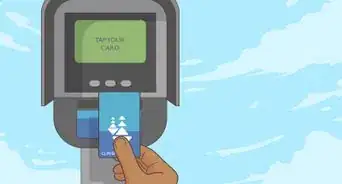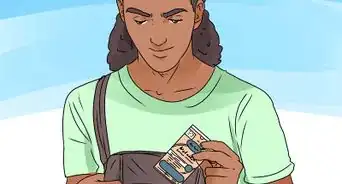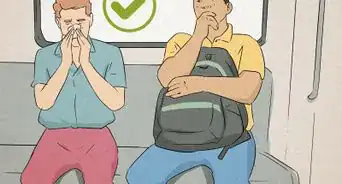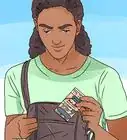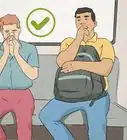X
wikiHow is a “wiki,” similar to Wikipedia, which means that many of our articles are co-written by multiple authors. To create this article, 33 people, some anonymous, worked to edit and improve it over time.
This article has been viewed 99,154 times.
Learn more...
BART, or Bay Area Rapid Transit, is a train system that serves San Francisco and the East Bay. BART can be a great way to avoid driving and spend less time sitting in traffic. It can also be a good alternative to finding and paying for parking in San Francisco.
Steps
Part 1
Part 1 of 3:
Planning Your Trip
-
1Review the route map and find the stations nearest where you wish to go. There are five lines, referred to by their end points (not by their colors).
- Richmond ↔ Daly City - Millbrae: The line terminates at Millbrae on weeknights before 8 PM. At all other times except Sundays, this line terminates at Daly City. This line does not run on Sunday.
- Warm Springs or Fremont ↔ Richmond: The line runs to Warm Springs on evenings and weekends, and to Fremont on weekdays before the evening)
- Warm Springs or Fremont ↔ Daly City: The line runs to Warm Springs on weekdays before the evening, and to Fremont on Saturday; it does not run in the evenings or on Sundays
- Pittsburg / Bay Point ↔ SFO: When the Richmond - Millbrae line is not running (i.e., on evenings and weekends), this line also goes to Millbrae
- Dublin / Pleasanton ↔ Daly City
-
2Find the stations nearest your starting point and your destination, and determine the trains to use to get from the former to the latter. You can use BART's "Find Closest Station" feature.[1] Then check the schedule (keep in mind that the schedule differs for weekdays and weekends).[2] Decide when you wish to arrive at your destination and work back from that.
- The BART schedule is very complex. Some lines change destinations based on time. All lines have variable schedules based on day and time. If you are unfamiliar with the BART schedule, check online first. Once you enter the station, there are station maps within the station that you can access.
Advertisement -
3Find out the fare required for the trip you will take. BART determines fares based on the point of entry and exit, and one-way fares range from $1.95 (for stations that are within 6 miles of one another) to $15.70 (between the San Francisco International Airport and the Oakland International Airport). You can use the fare calculator on the BART website.[3] [4]
-
4Use route-planning tools such as Google Maps[5] or competing services, on the web or an appropriate app on your phone. When using these services, you may need to select the public transit option, and you may be shown options other than BART. Google Maps also includes a fare when it shows routes. You may also use the Google Maps Schedule Explorer to get a clearer idea of additional options and their timings.
Advertisement
Part 2
Part 2 of 3:
At the Station
-
1Go to the BART station where you start your trip. You may use your mapping tool to guide yourself toward the station. Look for the BART logo to identify the station. You can also look for 15 foot pillars with the name of the station and the BART logo, along with escalators and elevators going down.
- If you will park a car at the BART station, be aware that parking at some locations fills up very early on weekdays. Also, some stations charge a nominal fee to park. Reserved parking, daily parking, and long-term airport parking permits are available for purchase. Note that not all stations have parking. In the BART system map, stations that have parking are designated with a P.[6]
-
2Buy a ticket. Ticket machines at each station take cash and change as well as credit and debit cards. Many retail locations near BART lines also sell tickets.
- Tickets are sold according to how much money you put on them. You can add fare to a ticket while you are inside the BART system.
- Check to see if you are eligible for any of the discounts. Students, seniors, and "persons with disabilities, Medicare cardholders and children 5 to 12 years old" are eligible.
- You can put enough money on one ticket for multiple rides and use it several times.
- BART charges your ticket based only on where you enter the system and where you exit the system, so there is no charge for changing trains. You need to use your ticket or card at both entry and exit.
- When making a roundtrip, if you know exactly how much you will spend on the roundtrip, add enough fare for the roundtrip when buying the ticket. This will reduce your time spent waiting in line on the return journey.
- Starting in 2021, BART ticket machines only dispense Clipper Cards.
- If you are a one-time BART user and are not sure what your exact fare should be, it is better to underpay initially and use the Add Fare gate if you have insufficient balance to exit.
-
3Check for announcements about system-wide delays before entering the station. Such announcements are available on BART's website[7] and will also be displayed at the station. This is particularly important if it is very critical for you to be at your destination by a specific time.
-
4Tap your Clipper Card to the entrance reader. Keep your Clipper Card with you, since you will need it to exit BART on the other end.
- Walk on the left side of escalators, and stand to the right. Do not bring strollers, bikes, large suitcases, etc on escalators.
- Follow the signs and listen carefully to the announcements. Generally, the automated announcements for trains in one direction are made by a male and the automated announcements for trains in the other direction are made by a female.
- BART etiquette is to leave a space for passengers exiting the train, and then board.
- If you need to use the elevator, pay before proceeding to the elevator.
Advertisement
Part 3
Part 3 of 3:
Taking the Train
-
1Board the correct train and ride BART to your destination.
- Trains are supposed to stop so that the doors of the train align with the black demarcated areas in the yellow strip adjacent to the tracks on the platform. During crowded hours, people generally form lines in front of the black areas.
- Trains vary in length from 3 to 10 cars. Each station can accommodate a ten-car train in each direction, and has twenty designated black demarcated areas where train doors may open (two per car, although the new trains that are progressively being rolled out have three doors per car). Trains with an even number of cars stop leaving an equal amount of space at the front and back (so for instance an 8-car train will leave 1 car of space in front and 1 car at the back when it stops). Trains with an odd number of cars leave an additional car's worth of space in the front than in the back (so for instance a 7-car train will leave 2 cars of space in the front and 1 in the back). Downtown San Francisco stations have markers on the walls indicating the beginning and end of the boarding zone for trains of different car lengths, but not all BART stations have these markers. Both the automated voice announcements and the automated displays include the number of cars in the train, so use this information to position yourself within the platform.
- A good rule of thumb is that, generally, the middle cars of a train are likely to be the most crowded, because most stations are designed so that the entrance to the platform is in the middle, and most people don't walk over to the ends of the platform. To maximize the chance of getting seating space or comfortable standing space, board the front or rear car of the train. Note, however, that bicycles are not allowed on the front car.
-
2Practice good train etiquette.
- Do not stand in the doorway for long, or try to walk through the doors as they are closing. Be particularly careful about rushing bikes through doorways. Jammed doorways can hold up the train for you and your fellow passengers, and also prevent additional trains from arriving at the station.
- The seats closest to the doors are for the elderly, pregnant women, and disabled people. Please yield these seats to those in need of them. If there are other vacant seats, use them so that you won't need to vacate your seat on demand.
- Some seats on the train face other seats. These usually have less leg room, so avoid these seats if you care about leg room.
- Keep your belongings off the seat next to you and off the aisles. Place them on your lap or under your seat. If you are standing, you have a backpack and the train is reasonably crowded, take off your backpack and place it between or next to your feet, so as to make more space for others.
- If standing, do not cluster near the doors if there is space elsewhere within the train. Move to the middle or ends of the car. Do not lean against the doorways. If standing near the doors, keep in mind that doors open on different sides at different stations.
-
3Exit the train.
- Keep in mind that doors open on different sides at different stations. On two-track island platform stations, doors open on the left, whereas on stations with separate platforms for each side, doors open on the right. At timed transfer stations such as MacArthur, 12th Street, and 19th Street, there are island platforms where both trains are traveling in the same direction, so one of them has doors opening on the left and the other has doors opening on the right. Also keep in mind that unlike many other train systems, the direction in which doors will open is not announced by the train operator, so you need to pay attention to the station geography or other people's behavior.
- If you are far from the car door, make your way to the door in advance of arriving at the station.
- Check for all your personal items before making your way to the door. If you are missing a personal item, take a little time to search for it. You can report lost items to the station agent or recover them from the BART website.
- If you miss getting off at your designated station (either because you don't notice it, or it's too crowded, or you are looking for a missing item) stay calm and get off at the next station, then ride a train in the opposite direction. You will not be charged extra for doing so.
-
4Insert the ticket into the turnstile (or touch your card) on your way out. If any fare is left on the ticket, it will be returned to you for further use
- Do not exit through an emergency exit, otherwise you might be charged a much larger fee a few hours later as BART does not know where you exited.
- Since exits tend to be clustered at the times when trains arrive at the station, you may need to wait in line to exit. Be sure to keep your card or ticket out and ready to use for when it's your turn, so as not to waste other people's time.
- Sometimes, fare gates don't work, and say "See Agent". Before seeing an agent, try an alternative fare gate. If the alternative fare gate doesn't work either, then see an agent. Do not just leave the station through an emergency exit.
- If you see an "Insufficient value on card" message at the fare gate, use the AddFare booths inside the station to add value. Note that these booths can only be used to add enough value to exit the station. You need to use the booths outside the paid area of the BART system to add more value.
Advertisement
Community Q&A
-
QuestionHow do I know which train to get on?
 Community AnswerOn the announcement board, there will be different routes you can ride. Look on the map and check which route you want to take. That is the only way to figure out the train - there is no train number.
Community AnswerOn the announcement board, there will be different routes you can ride. Look on the map and check which route you want to take. That is the only way to figure out the train - there is no train number. -
QuestionWhat does "2-door" mean?
 Hugo BilliauCommunity Answer2-door trains are the current fleet of trains operating on the BART. They are called 2-door trains because they have 2 sets of doors on either side of the train. Newer trains, planned to come 2023, will have 3 sets of doors to improve the number of passengers able to get on.
Hugo BilliauCommunity Answer2-door trains are the current fleet of trains operating on the BART. They are called 2-door trains because they have 2 sets of doors on either side of the train. Newer trains, planned to come 2023, will have 3 sets of doors to improve the number of passengers able to get on. -
QuestionAre BART tickets able to be purchased at a lower cost for old people?
 Hugo BilliauCommunity AnswerYes, seniors get a 62.5% discount on their tickets. But you need to apply for a clipper discount on https://www.bart.gov/tickets
Hugo BilliauCommunity AnswerYes, seniors get a 62.5% discount on their tickets. But you need to apply for a clipper discount on https://www.bart.gov/tickets
Advertisement
Warnings
- Do not "swipe" in and out at the same station as BART will charge you a $5.75 "Excursion Fare". In the event that you realize shortly after entering the station that you shouldn't have entered it, talk to the station agent (whose booth is near the fare gates) so he/she can let you out without you getting charged.⧼thumbs_response⧽
- Don't leave valuables in your car at a BART station.⧼thumbs_response⧽
- BART Tickets are magnetic. Do not place them near any electronic device (Cell Phone, iPod, etc.) or near cards with magnetic strips, such as credit cards, as this may demagnetize the ticket, resulting in the gates not opening when you insert your ticket into the machine. If your ticket has been demagnetized, see the station agent.⧼thumbs_response⧽
- Unlike some mass transit systems, BART does not operate 24 hours a day. The last departure happens around midnight and the last arrival happens around 1 AM. Service does not resume until 4am on weekdays, 6am on Saturdays and 8am on Sundays.⧼thumbs_response⧽
- BART cars and stations have video monitoring and BART has its own police department. Conduct yourself accordingly.⧼thumbs_response⧽
- BART trains are electric. Never touch the tracks.⧼thumbs_response⧽
- As with all trains, BART moves quickly and can't stop in a short distance. Wait behind the yellow line, a safe distance from the tracks.⧼thumbs_response⧽
Advertisement
References
About This Article
Advertisement
-Step-1.webp)
-Step-2.webp)
-Step-3.webp)
-Step-4.webp)
-Step-5.webp)
-Step-6.webp)
-Step-7.webp)
-Step-8.webp)
-Step-9.webp)
-Step-10.webp)
-Step-11.webp)
-Step-12.webp)
